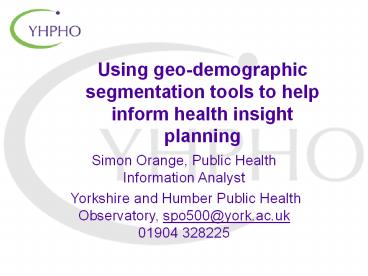Using geo-demographic segmentation tools to help inform health insight planning
1 / 18
Title:
Using geo-demographic segmentation tools to help inform health insight planning
Description:
Using geo-demographic segmentation tools to help inform health insight planning Simon Orange, Public Health Information Analyst Yorkshire and Humber Public Health ... –
Number of Views:84
Avg rating:3.0/5.0
Title: Using geo-demographic segmentation tools to help inform health insight planning
1
Using geo-demographic segmentation tools to help
inform health insight planning
Simon Orange, Public Health Information Analyst
Yorkshire and Humber Public Health Observatory,
spo500_at_york.ac.uk 01904 328225
2
Segmentation
- A process of looking at the audience or market
and seeking to identify distinct sub-groups
(segments) that may have similar needs, attitudes
or behaviours. - The aim of any segmentation should be to define a
small number of groups so that - all members of a particular group are as similar
to each other as possible - they are as different from the other groups as
possible
3
Types of Segmentation
- Demographic - Divides people into groups based
on variables such as age, gender, race. - Geographic - Divides people into groups based
on different geographical units such as
regions. - Geo-demographic - Combines demographics and
geography into a segmentation. Identify
groups of small geographic areas that have
similar demographic profiles. - Behavioural - Divides people into groups based
on the way they respond to, use, or know of a
product or service.
4
Geodemographics
- Geodemographics has been defined as the analysis
of people by where they live. - Use of geography to help us draw general
conclusions about the characteristics and
behaviours of the people who live in them. - Similar people live in similar places, do similar
things and have similar lifestyles birds of a
feather flock together.
5
Geodemographic Segmentation
6
Tool Creation
7
Tools Available
8
Segmentation Profiles
9
Example of Profiling cervical screening for
Yorkshire and the Humber
10
Example of Profiling cervical screening for
Bradford
11
Segmentation Profiles
Baseline Profile
Target Profile
Struggling families
Struggling families
Secure Families
Burdened Singles
Source HES data
12
Mapping
13
Health Intelligence Practice Profiles
14
Identifying areas with excess expected
prevalence/incidence
15
Comparison
16
How do they add value?
- Population health profiling
- Understanding the characteristics of small
geographical areas. - Mapping and visualisation.
- Targeting health interventions by identifying
areas with excess expected prevalence/incidence
etc. - Measurement of health inequalities by
- Explaining variation in health determinants,
outcomes or services. - Providing a more granular measure of health
inequality. - Social marketing and communications
- Support data linkage, and non-disclosable data
sharing. - As a base for generating additional insight - on
top of the off-the-shelf descriptions.
17
What geodemographics can not tell us.
- Birds of a feather may not always flock together
- Census 2001 data dependent
- Analysis of the profiles is usually based on
probabilities, rather than hard data. - Not really intended to be used as a trend
monitoring tool. Cannot quickly detect change - Geodemographics in themselves do not provide the
answer. They are simply one of a range of tools
and approaches that can be used to generate
insight and health intelligence to support social
marketing decisions.
18
Simon Orange, Public Health Information Analyst
Yorkshire and Humber Public Health Observatory,
spo500_at_york.ac.uk 01904 328225































